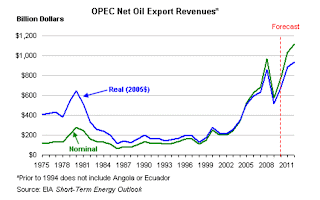I wish I really knew. I've recently been reading Robert Bryce,
Power Hungry: The Myths of “Green” Energy and the Real Fuels of the Future (2010). He devotes several chapters to the deficiencies of wind power. He shows the danger to the bird population and has on his side the
American Bird Conservancy. But he singles out “intermittency” as the really fatal flaw, because it requires investment in capital plants for other forms of power generation (coal, natural gas, and nuclear) sufficient to carry the load when the wind doesn’t blow and the sun doesn’t shine.
He was making a believer out of me. Now I'm wracked by doubt again.
The following article from the
Green Economy Post (May 23, 2011) says Bryce does not know what he's talking about and argues that the costs of intermittency are in fact miniscule.
Electricity markets reward generating companies in three different ways:
1. Energy
2. Capacity
3. Ancillary services
Energy is straightforward: the buyer pays for energy, measured in kilowatt-hours. It’s like buying ice cream on a hot day: the seller gets paid to meet an immediate need. There is no guarantee that either party will come back tomorrow.
Capacity is also easy to understand. If you can guarantee me in January that you will be there to meet my need for ice cream on the hottest day of July, then that’s valuable. And it gets a separate (smaller) payment.
Finally, there is a market for ancillary services, which is more complex. Ancillary service providers are there to step in when the grid needs help — to maintain voltage or frequency, or to maintain technical parameters like power factor. To stretch the ice cream analogy a bit, it would be like having a friend follow you around with a cooler filled with ice cream just in case you needed it. Even if you never had a craving, you’d still have to pay them something to be “on standby” all the time.
For the most part, wind farm owners rely on getting paid for “energy-only.” There are occasions where wind energy warrants some degree of capacity payment or even ancillary services payments. But for the most part, the value of wind capacity is low, about 10 to 20% of nameplate capacity. So, a 100-MW wind farm is only worth as much as 15 MW of nuclear power from a capacity standpoint.
However, the energy in wind is worth 100% of the energy in nuclear (or anything else) in the spot market; wind energy in the day-ahead market may be worth a little less, but this can be “firmed” using energy trading desks or by using other assets in the operator’s fleet (e.g., wind farm owners may also own natural gas turbines that can deliver any shortfall in the forecast). . . . intermittency is no big deal — the energy markets have already accounted for all this.
[Scholars like Robert Bryce of the Manhattan Institute see] “a hideous externality driven by the near-zero marginal cost of production for wind. Wind turbines use no fuel. This means that wind farm operators can always underbid fossil fuels in the spot market.”
Always. Think about that: the fossil fuel plant is humming along and a storm front moves in. The wind whips up, and the wind farms bid in nearly free power. Well, fossil fuel costs money, so the fossil-plant operator will often choose to ramp down rather than sell electricity for free. But then the storm front moves through quicker than expected — and the fossil plant has to ramp up again. Up and down, over and over, all year long. This is wasteful. It causes increased maintenance. It is an externality imposed on the fossil fuel operators by those darned, fickle winds.
The cycling of fossil fuel plants has been studied for many years, and the generalized form of this problem is called the cost of “wind integration.” As Michael Milligan, a researcher at the National Wind Technology Center, puts it, there are four costs to integrating wind:
1. Committing unneeded generation
2. Allocating extra load-following capability
3. Allocating additional regulating capacity
4. Increased cycling operation
. . . The key point for the layman to understand is that the implicit cost of all of these effects can be seen in the ancillary services market (i.e., what it costs the system operator to pay for backup). If there is greater uncertainty, then generators will charge more for providing backup.
How much more? Many studies have found the cost of wind integration to be in the $3 to $5 per MWh range. Or about FOUR TENTHS of a cent per kWh.
That’s it. All you are paying for is a little fuel and a little maintenance.

















